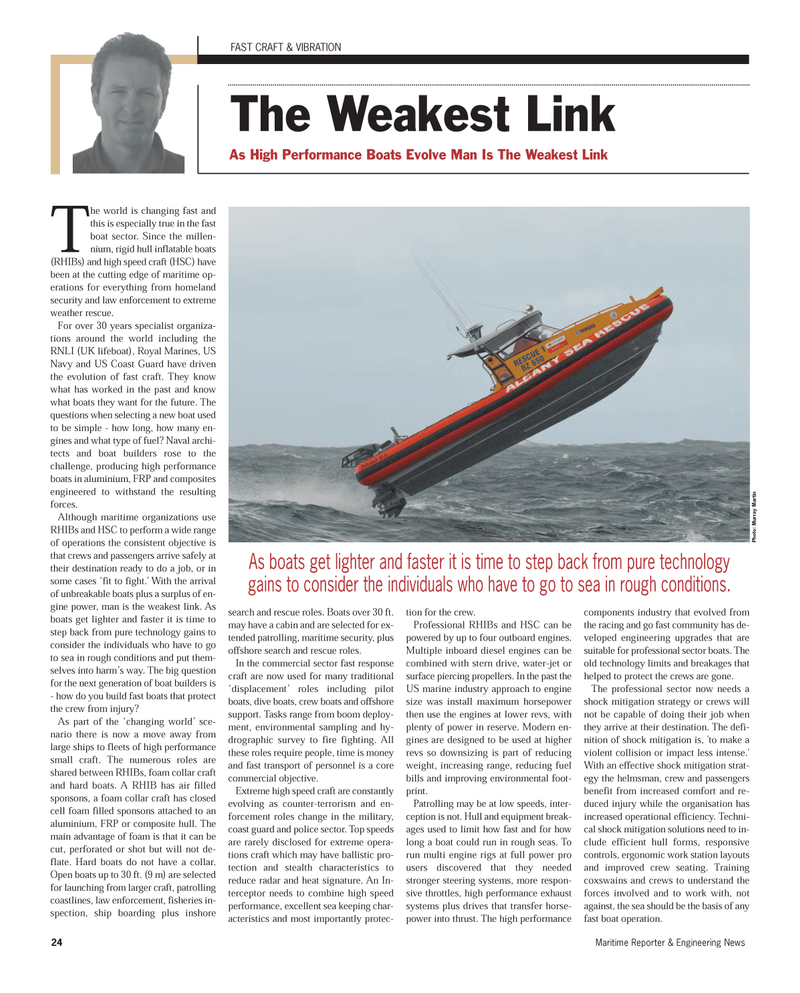
Page 24: of Maritime Reporter Magazine (November 2012)
Workboat Annual
Read this page in Pdf, Flash or Html5 edition of November 2012 Maritime Reporter Magazine
24Maritime Reporter & Engineering News The world is changing fast and this is especially true in the fast boat sector. Since the millen- nium, rigid hull inflatable boats(RHIBs) and high speed craft (HSC) have been at the cutting edge of maritime op-erations for everything from homeland security and law enforcement to extreme weather rescue. For over 30 years specialist organiza- tions around the world including the RNLI (UK lifeboat), Royal Marines, US Navy and US Coast Guard have driven the evolution of fast craft. They know what has worked in the past and know what boats they want for the future. The questions when selecting a new boat used to be simple - how long, how many en- gines and what type of fuel? Naval archi- tects and boat builders rose to the challenge, producing high performanceboats in aluminium, FRP and compositesengineered to withstand the resultingforces.Although maritime organizations use RHIBs and HSC to perform a wide rangeof operations the consistent objective is that crews and passengers arrive safely at their destination ready to do a job, or insome cases ?fit to fight.? With the arrival of unbreakable boats plus a surplus of en-gine power, man is the weakest link. As boats get lighter and faster it is time to step back from pure technology gains to consider the individuals who have to go to sea in rough conditions and put them-selves into harm?s way. The big question for the next generation of boat builders is - how do you build fast boats that protect the crew from injury? As part of the ?changing world? sce- nario there is now a move away from large ships to fleets of high performance small craft. The numerous roles are shared between RHIBs, foam collar craftand hard boats. A RHIB has air filled sponsons, a foam collar craft has closedcell foam filled sponsons attached to an aluminium, FRP or composite hull. The main advantage of foam is that it can be cut, perforated or shot but will not de- flate. Hard boats do not have a collar. Open boats up to 30 ft. (9 m) are selectedfor launching from larger craft, patrolling coastlines, law enforcement, fisheries in- spection, ship boarding plus inshoresearch and rescue roles. Boats over 30 ft. may have a cabin and are selected for ex- tended patrolling, maritime security, plus offshore search and rescue roles. In the commercial sector fast response craft are now used for many traditional ?displacement? roles including pilot boats, dive boats, crew boats and offshore support. Tasks range from boom deploy- ment, environmental sampling and hy- drographic survey to fire fighting. All these roles require people, time is money and fast transport of personnel is a core commercial objective. Extreme high speed craft are constantlyevolving as counter-terrorism and en- forcement roles change in the military, coast guard and police sector. Top speeds are rarely disclosed for extreme opera- tions craft which may have ballistic pro- tection and stealth characteristics toreduce radar and heat signature. An In- terceptor needs to combine high speedperformance, excellent sea keeping char- acteristics and most importantly protec-tion for the crew. Professional RHIBs and HSC can bepowered by up to four outboard engines. Multiple inboard diesel engines can becombined with stern drive, water-jet or surface piercing propellers. In the past the US marine industry approach to enginesize was install maximum horsepower then use the engines at lower revs, with plenty of power in reserve. Modern en- gines are designed to be used at higherrevs so downsizing is part of reducing weight, increasing range, reducing fuelbills and improving environmental foot- print. Patrolling may be at low speeds, inter- ception is not. Hull and equipment break-ages used to limit how fast and for how long a boat could run in rough seas. To run multi engine rigs at full power pro users discovered that they needed stronger steering systems, more respon-sive throttles, high performance exhaust systems plus drives that transfer horse- power into thrust. The high performance components industry that evolved from the racing and go fast community has de- veloped engineering upgrades that are suitable for professional sector boats. The old technology limits and breakages thathelped to protect the crews are gone. The professional sector now needs a shock mitigation strategy or crews will not be capable of doing their job whenthey arrive at their destination. The defi- nition of shock mitigation is, 'to make a violent collision or impact less intense.'With an effective shock mitigation strat- egy the helmsman, crew and passengers benefit from increased comfort and re- duced injury while the organisation has increased operational efficiency. Techni- cal shock mitigation solutions need to in- clude efficient hull forms, responsive controls, ergonomic work station layouts and improved crew seating. Training coxswains and crews to understand the forces involved and to work with, not against, the sea should be the basis of any fast boat operation. FAST CRAFT & VIBRATION The Weakest Link As High Performance Boats Evolve Man Is The Weakest Link As boats get lighter and faster it is time to step back from pure technology gains to consider the individuals who have to go to sea in rough conditions. Photo: Murray Martin MR#11 (18-25):MR Template 10/22/2012 4:11 PM Page 24

 23
23

 25
25
